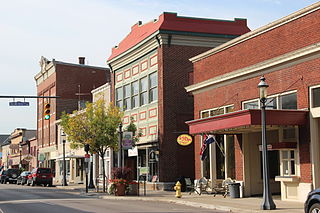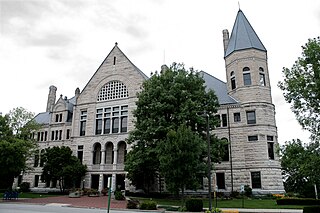Related Research Articles

Dayton is the sixth-largest city in the U.S. state of Ohio. The county seat of Montgomery County, it anchors the state's fourth-largest metropolitan area. A small part of the city extends into Greene County. As of the 2020 census, the city proper had a population of 137,644, while the Dayton metropolitan area had 814,049 residents. Dayton is located within Ohio's Miami Valley region, 50 miles (80 km) north of Cincinnati and 60 miles (97 km) west of Columbus. It is a principal city of the Dayton–Springfield–Sidney combined statistical area, home to a population of 1,086,512.

Michael Graves was an American architect, designer, and educator, and principal of Michael Graves and Associates and Michael Graves Design Group. He was a member of The New York Five and the Memphis Group – and a professor of architecture at Princeton University for nearly forty years. Following his own partial paralysis in 2003, Graves became an internationally recognized advocate of health care design.

Miamisburg is a city in southern Montgomery County, Ohio, United States. The population was 19,923 at the 2020 census. A suburb of Dayton, it is part of the Dayton metropolitan area. Named after the Miami people, Miamisburg is known for its industrial history, particularly its nuclear operations during World War II, and retail factors such as the Dayton Mall and surrounding commercial business area.

The University of Dayton (UD) is a private, Catholic research university in Dayton, Ohio. Founded in 1850 by the Society of Mary, it is one of three Marianist Universities in the United States and the second-largest private university in Ohio. The university's campus is in the city's southern portion and spans 388 acres on both sides of the Great Miami River. The campus is noted for the Immaculate Conception Chapel and the University of Dayton Arena.

Arthur Cotton Moore was an American architect who achieved national and international recognition for his contributions to architecture, master planning, furniture design, painting, and writing.

NBBJ is an American global architecture, planning and design firm with offices in Boston, Columbus, Hong Kong, London, Los Angeles, New York, Portland, Pune, San Francisco, Seattle, Shanghai, and Washington, D.C..
"America's Favorite Architecture" is a list of buildings and other structures identified as the most popular works of architecture in the United States.
Frances Halsband FAIA is an American architect and educator. She is a founder, with Robert Kliment, of Kliment Halsband Architects, a New York City design firm widely recognized for preservation, adaptive reuse and master planning projects. Significant works include The Brown University Framework for Physical Planning, Long Island Railroad Entrance at 34 Street, Visitor Center at Franklin Roosevelt Presidential Library, Mount Sinai Ambulatory Surgery Facility Kyabirwa Uganda. The firm received the AIA Firm Award in 1997 and the New York AIA Medal of Honor in 1998.

Cooper Robertson is an international architecture and urban design firm, headquartered in New York City. It was founded in 1979 by Alex Cooper and Jaquelin T. Robertson.

James W. McLaughlin was a Cincinnati, Ohio architect. He studied to be an architect working under famed James Keys Wilson. He fought in the American Civil War serving in the Union Army. During the late 19th century, he became a popular builder in Cincinnati. In 1870 he helped organize the Cincinnati chapter of the American Institute of Architects; that year, he was selected as a Fellow of the AIA, serving on its board.

SMBH, Inc. is a full-service structural engineering firm located in Columbus, Ohio. Providing structural engineering services for architects, contractors and building owners, SMBH, Inc. has experience designing educational facilities, medical centers, courthouses and commercial and residential buildings. Since 1972, SMBH, Inc. has served the architectural and construction communities in Ohio and surrounding states. SMBH, Inc. has worked with architectural firms such as Graham Gund's Gund Partnership, Mack Scogin Merrill Elam Architects, Peter Eisenman, and Robert A.M. Stern.

Fisher Hall was a building at Miami University in Oxford, Ohio. Originally the Oxford Female College, the building was later used as a sanitarium and was purchased by Miami in 1925. It served as a first-year men's residence hall, Naval training school, and theatre. The building remained in use as a dormitory until 1958, when the upper floors were condemned and the theatre remained the only part of the building still in use. With the construction of Miami's Center for Performing Arts in 1968, the theatre became unused and the building turned into a storage facility. After a push to save the building in the mid-1970s, the hall was razed because the cost of renovating the building was identical to the costs of new construction. Miami University's hotel, The Marcum, was built in 1982 on the former site of Fisher Hall.
Robert Andrews Little (1919–2005) was a modernist architect based in Cleveland, Ohio. He received the Cleveland Arts Prize for Architecture in 1965. Little practiced in the Bauhaus and International styles. He also designed and advocated energy-efficient features, and employed Jewish and African-American architects and engineers.
Champlin Architecture is an American architectural firm headquartered in Cincinnati, Ohio. The firm has designed buildings in the greater Cincinnati area and in other midwest cities.
Susan A. Maxman is an American architect who founded a firm called Susan Maxman Architects in 1985, which she expanded to Susan Maxman & Partners Ltd in 1995. Her firm is associated with a large number of projects involving a wide spectrum of architectural services, including design of old and new buildings, restoration and rehabilitation works, master and site planning, feasibility reports, programming, historic preservation, and interior design. She was the first woman elected as president of the American Institute of Architects in 1992. Her expertise in adoption of the "principles of sustainable design" in her projects has received national appreciation, and in 2011 Maxman was nominated by President Barack Obama to the board of directors of the National Institute of Building Sciences.

Gary Paul Haney FRIBA, FAIA is an American architect, a design partner in the firm of Skidmore, Owings & Merrill. Haney's approach draws heavily on environmental modeling techniques, deep materials research, and advanced building information modeling (BIM) technologies. Buildings on which he was lead designer include the supertall Al Hamra Tower in Kuwait City and civic buildings in the United States including two Public Safety Answering Centers in New York City and the United States Census Bureau headquarters and the redesign of the National Museum of American History, both in Washington, D.C.
Urban Design Associates is an international urban design and architecture firm headquartered in Pittsburgh, Pennsylvania, United States.
Bernardo Fort-Brescia is a US-based Peruvian businessman and architect. He is the co-founder of the architectural firm Arquitectonica. He is a fellow of the American Institute of Architects (AIA). He won the AIA Silver Medal. He is also an heir to Grupo Breca.
Guy Wesley Peterson is an American architect based in Sarasota, Florida. He has designed more than 200 structures in southwest Florida, including private and public works. Peterson is an adjunct professor of architecture at the University of Florida, College of Design, Construction and Planning, and the author of Naked: The Architecture of Guy Peterson.
References
- ↑ "Historical Director of American Architects". American Institute of Architects. Retrieved July 22, 2012.
- ↑ "Loeb Fellowship History". Graduate School of Design, Harvard. Retrieved July 22, 2012.
- ↑ J. William Rudd (2012). "Richardson's rocks: DAAP-designed Cincinnati memorial in Burnet Woods turns 40". UC Magazine.
- ↑ "Current News: Graduate Thesis Design Reviews". Miami University Architecture and Interior Design. 2007.
- ↑ "Lorenz & Williams History". LWC Website. Retrieved July 22, 2012.
- ↑ "Lorenz and Williams Inc". Architecture Week. 2007.
- ↑ "Stephen J. Carter". The American Institute of Architects. Retrieved July 22, 2012.
- ↑ "Lowcountry Directors". American Institute of Architects . Archived from the original on July 15, 2023. Retrieved July 15, 2023.